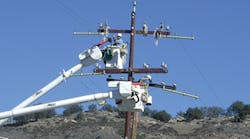As part of a reconductoring project, EROC crews upgraded infrastructure in Santa Ysabel, California.Late in 2014, SDG&E developed the FiRM program, which uses the learnings from previous programs to evaluate the performance of its 300,000 overhead poles over time. Through extensive data analysis, SDG&E found poles were not the issue rather the components on the poles (the conductor, splices and insulators), which could not withstand the heat and strong winds.As a result, SDG&E created a team to explore the reliability of its system in rural areas in more detail. Through the FiRM program, field crews travel into the back country, inspect all circuits and look for ways to improve and harden them so they could withstand winds up 85 mph. In doing so, SDG&E moved to significantly reduce or eliminate sources of ignition from overhead line work and, in turn, lower the public safety risk. In addition, the utility has moved to shut off circuits in areas where the wind values exceed design criteria. As a result, the utility has more control over its system and can protect the public as well as the system as a whole.During future phases of the project, SDG&E plans to move beyond the highest risk areas to other regions of the service territory. Creating a New Field TeamAs part of its system-hardening program, SDG&E created a new Electric Regional Operations Construction (EROC) team to help train up-and-coming linemen and to provide a new construction work mix for existing journeymen. Currently, this team is preparing to replace 800 to 1,000 wood poles with steel poles and perform the associated reconductoring work. Through this program, SDG&E rotates apprentices and line assistants through the team on three-month assignments. While workers have the opportunity to do energized and de-energized work on the system, for the most part, the crews try to keep facilities energized, except when a helicopter is setting steel poles or stringing wire. SDG&E senior leadership views the EROC team as an opportunity for new workers on the distribution crews to gain construction experience alongside journeyman workers. The members of the team are completely mobile and can travel from home to remote operating locations anywhere within the service territory. At any point in time, three four-person overhead line crews and two-person hand-digging crews are working in the back country where there is little to no truck access.The crews work 10 hours a day, six days a week, as part of the one-year pilot program. So far, SDG&E has invited its line hands and gas construction crew personnel to join the program, and is looking for as many people as possible to work within the EROC group. To make this possible despite the districts’ busy schedules, the workers are engaged in three-month rotations. While this process does increase the administrative burden, it is an effective way to extend the experience across the organization. When the EROC team started, it had no office space, no vehicles, no tooling and no storeroom. As such, it began working with different groups such as the fleet department to acquire line trucks and bucket trucks, and logistics to obtain tools and material. Because it is a new concept within the company’s operational group, head count could not be increased. By rotating the workers through the EROC group, however, it has eased the burden on the other construction centers, enabling them to free up field crew members.
